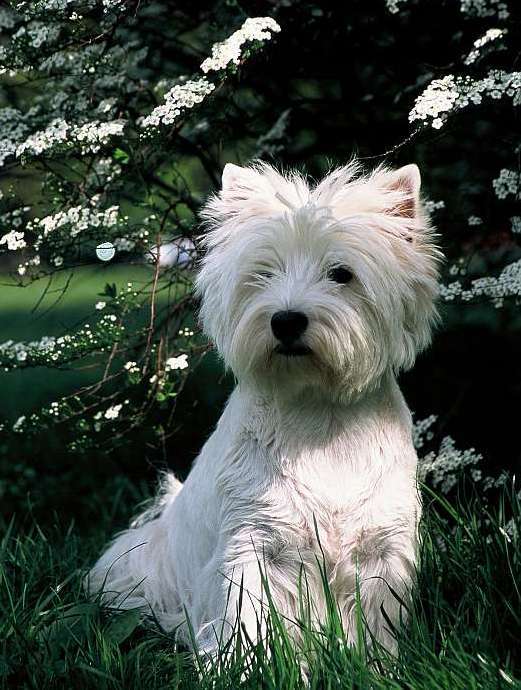Type the name of the breed you're looking for below
[wpdreams_ajaxsearchlite] Don't see the breed your're looking for? Click here and let us know!
Breed Characteristics
1 paw - breed exhibits the least amount of this characteristic
5 paws - breed exhibits most amount of this characteristic
West Highland White Terrier
| Other Names | Poltalloch Terrier, Roseneath Terrier, White Roseneath Terrier |
| Nicknames | Westie (or Westy) |
| Country of Origin | Scotland |
| Weight | Males: 15 - 22 lbs. (7 - 10 kg) Females: 13 - 16 lbs. (6 - 7 kg) |
| Height (at withers) | Males: 10 - 12 in. (25 - 30 cm) Females: 9 - 11 in. (23 - 28 cm) |
| Coat | The wiry coat of the Westie is a harsh double coat, and was originally developed to provide protection when hunting. The tail with full hair was necessary to pull the dog backwards out of shallow holes when it was digging and hunting varmints. |
| Colour | The traditional colour of the West Highland White Terrier is white, but some may be a wheat colour or a white with darker coloured paws. But in AKC shows the colours other than white will be disqualified, as that is the only acceptable standard colour of the West Highland White Terrier |
| Litter Size | 2 - 5 puppies average of 3 |
| Life Span | 12 - 14 years |
| Origin & History | Scottish white terriers were recorded as early as during the reign of James VI of Scotland, who reigned between 1567 and 1625. The king ordered that a dozen terriers be procured from Argyll to be presented to the Kingdom of France as a gift. Sandy and brindle coloured dogs were seen as hardier than those of other colours, and white dogs were seen as being weak. At various times during the breed's existence, it has been considered a white offshoot of both the Scottish Terrier and the Cairn Terrier breeds. There were also reports of a ship from the Spanish Armada being wrecked on the island of Skye in 1588. This ship carried white Spanish dogs, whose descendants were kept distinct from other breeds by Clan Donald, including the families of the Chiefs. Other families on Skye preserved both white and sandy coloured dogs. One such family was the Clan MacLeod, and it was reported by their descendants that at least two Chiefs kept white terriers, including "The Wicked Man" Norman MacLeod, and his grandson Norman who became Chief after his death. George Campbell, 8th Duke of Argyll, chief of Clan Campbell, bred a breed of white Scottish terriers known as the "Roseneath Terrier". Another breed of white Scottish terriers also appeared at this point, with Dr. Americ Edwin Flaxman from Fife developing his line of "Pittenweem Terriers" out of a female Scottish Terrier which produced white offspring. The dog seemed to produce these white puppies regardless of the sire to which it was bred, and after drowning over twenty of these offspring, he came upon the theory that it was an ancient trait of the Scottish Terrier that was trying to re-appear. He rededicated his breeding program to produce white Scottish Terriers with the aim of restoring it to the same stature as the dark coloured breed. Flaxman is credited with classes being added to dog shows for white Scottish Terriers towards the end of the 19th century. The person most closely associated with developing the modern breed of West Highland White Terrier is Edward Donald Malcolm, 16th Laird of Poltalloch. Malcolm owned terriers used to work game, the story told is that a reddish-brown terrier was mistaken for a fox and shot. Following this Malcolm decided to develop a white terrier breed, which became known as the "Poltalloch Terrier". The first generation of Poltallochs had sandy coloured coats, and had already developed prick ears which is a trait seen later in the modern breed. It is unknown if the Poltalloch Terriers and Pittenweem Terriers were interbred. In 1903 Malcolm declared that he didn't want to be known as the creator of the breed and insisted that his breed of white terriers was renamed. The term "West Highland White Terrier" first appears in Otters and Otter Hunting by L.C.R. Cameron, published in 1908. The first breed club was set up in 1904; Niall Campbell, 10th Duke of Argyll, was the society's first president. A second club was subsequently set up, with the Countess of Aberdeen as chairman. Edward Malcolm succeeded the Countess as the club's second chairman. Kennel Club recognition followed in 1907, and the breed appeared at Crufts for the first time in the same year. The Westie was imported into the United States in 1907–1908, when Robert Goelet imported Ch. Kiltie and Ch. Rumpus Glenmohr. Initially it was also known at the time as the Roseneath Terrier, and the Roseneath Terrier Club was recognised by the American Kennel Club in 1908. The club was renamed during the following year to the West Highland White Terrier Club of America. The breed spent the period that immediately followed as being "in vogue", becoming popular almost immediately upon its arrival in the US. Canadian Kennel Club recognition followed in 1909. Until 1924 in the UK, Westie pedigrees were allowed to have Cairn and Scottish Terriers in them. By the time of Malcolm's death in 1930, a stable type had appeared with prick ears, a white coat and a short back. In major conformation shows, the breed have been equally successful on both sides of the Atlantic. The first member of the breed to win a show championship was Ch. Morvan in 1905, owned by Colin Young. The dog was registered at the time as a Scottish Terrier, and won the title at the Scottish Kennel Club show at the age of seven months. Because the breed wasn't yet recognised independently, the championship title wasn't retained when the dog was re-registered as a West Highland White Terrier. The first win at a major show came at the Westminster Kennel Club Dog Show in 1942 when Constance Winant's Ch. Wolvey Pattern of Edgerstoune won the title of Best in Show. The same title was taken by Barbara Worcester's Ch. Elfinbrook Simon in 1962. It took a further fourteen years before the breed took its first Best in Show title at Crufts, the UK's major dog show. Ch. Dianthus Buttons, owned by Kath Newstead and Dorothy Taylor, took the title for the breed in 1976. The most recent win for the breed at a major show was again at Crufts, this time in 1990 with the Best in Show title going to Derek Tattersall's Ch. Olac Moon Pilot. The popularity of the breed during the early 20th century was such that dogs were being exchanged for hundreds of guineas. As of 2010, the Westie is the third most popular breed of terrier in the UK, with 5,361 puppies registered with the Kennel Club. However, this is a decrease in numbers since 2001, when it was the most popular terrier breed, with 11,019 new dogs registered. The breed's position in the United States is more stable with it remaining in the top third of all breeds since around 1960. It was ranked 30th most popular in 2001, based on registrations with the American Kennel Club, which has varied around the 30s in the decade since, with it ranked 34th in 2010. |
| Personality | The West Highland White Terrier is a game and hardy little terrier that is easy to train. It is fairly friendly toward strangers and gets along well with children. Easy dog to travel with. These dogs are lively and extremely self-assured toward other dogs, but will not pick fights if their owners know how to display proper leadership. They may chase a cat for fun, and need to be corrected if they do attempt this. Robust, friendly and spirited, Westies just love companionship. Despite their size, they make a very good watchdog. The Westie likes to dig and bark. If a Westie is allowed to become the pack leader, it may snap when irritated and be combative with other dogs. A lack of leadership on the owner’s part can cause many behavior problems, such as biting, guarding food and furniture. A Westie that has an owner who knows how to display firm, confident, consistent, leadership will not experience these behavioral problems. These problems can be corrected once the owner becomes the dog’s true pack leader. Do not allow the Westie to develop Small Dog Syndrome. |
Care Requirements
| Health | Prone to chronic hernias, liver disease Legg-Cavé-Perthes syndrome (hip problems), jawbone calcification, cherry eye and skin problems. |
| Grooming | The harsh, straight, shorthaired double coat is fairly easy to groom and sheds little to no hair. Simply brush regularly with a stiff bristle brush. Brushing should keep the coat clean, so bathe only when necessary. Trim around the ears and eyes with blunt-nosed scissors. The whole coat should be trimmed about every four months and stripped twice a year. |
| Exercise | These little dogs need a daily walk. Play will take care of a lot of their exercise needs, however, as with all breeds, play will not fulfill their primal instinct to walk. Dogs that do not get to go on daily walks are more likely to display behavior problems. They will also enjoy a good romp in a safe, open area off lead, such as a large, fenced-in yard. |
| Other Considerations | West Highland White Terriers are suitable for people in towns and cities as well as in the country. They are very active indoors and will do okay without a yard. In popular culture; In public life: Muhammed Ali Jinnah, founder of Pakistan, was known to own a Westie. In branding; Black & White whisky have used both Scottish Terriers and Westies in their advertisements, and the breed is used as the mascot of dog food Cesar. The Australian dog food manufacturer Mars Incorporated uses the West Highland White Terrier breed as the 'face' of their 'My Dog' brand. The Westie can be seen on 'My Dog' packaging, website and television and print commercials. In film; The film The Adventures of Greyfriars Bobby, released in the UK in February 2006, cast a West Highland White Terrier as Bobby. The appearance of a Westie caused protests from the Skye Terrier breed club, who complained about the filmmaker's use of an incorrect dog breed for the part. In television; The titular character in the BBC Scotland produced television series Hamish Macbeth owned a Westie named "Wee Jock". On Brazilian television animated series "As Aventuras de Gui & Estopa" (The Adventures of Gui & Estopa), the main character Gui, is the Terrier breed. |



